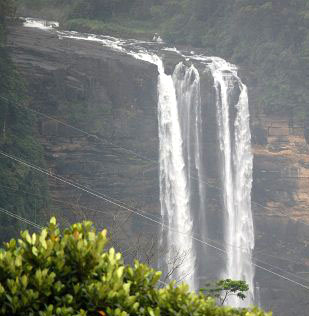

2010 - 2021 :
Sri Lanka
100 Rupee note
Development, Prosperity and Dancers
The Central Bank of Sri Lanka
(CBSL) issued, for circulation,
a new series of currency notes on the theme "Development, Prosperity and Sri Lanka Dancers"
on 2011 February 4th, dated 2010-01-01.
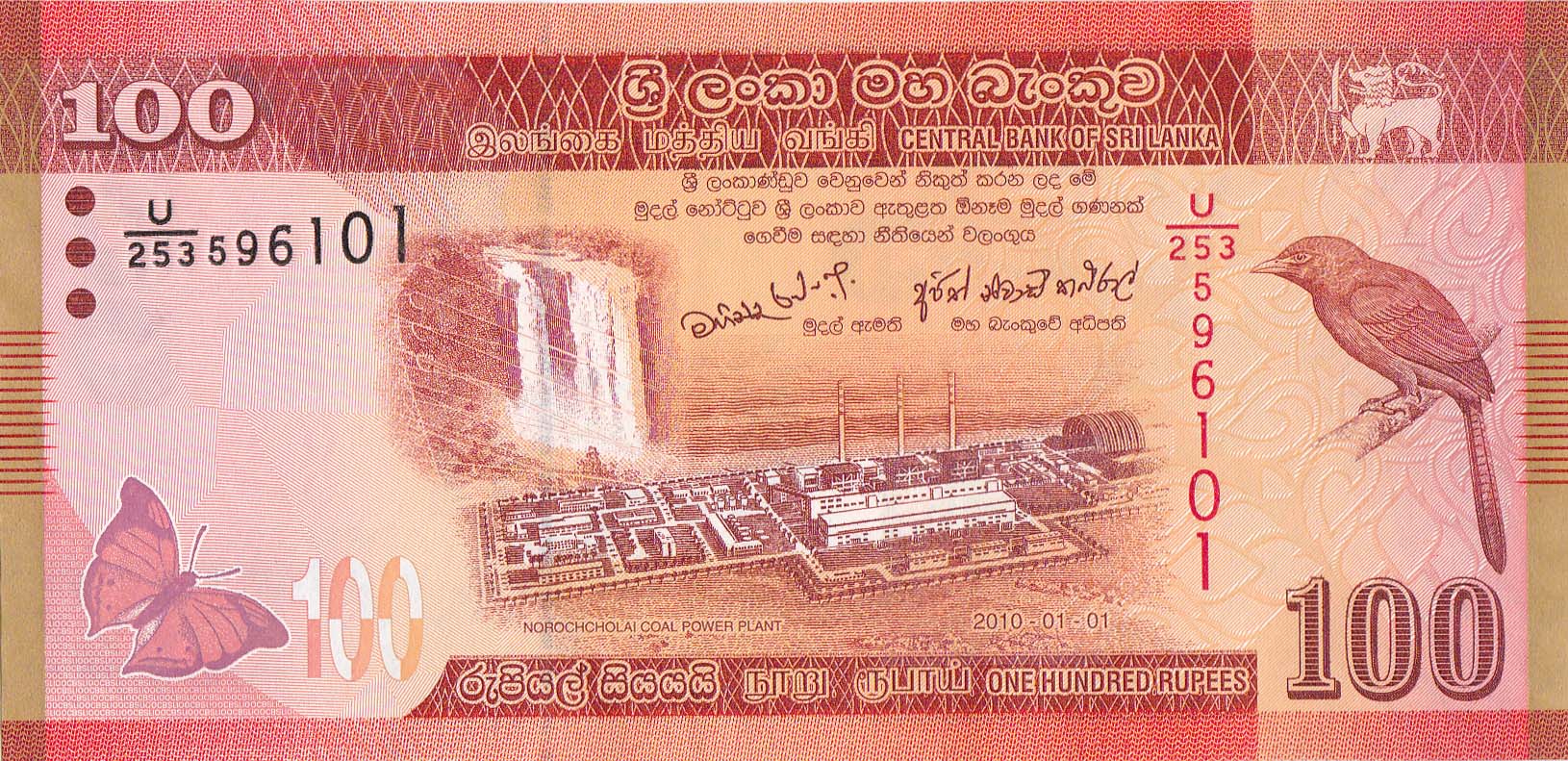
| 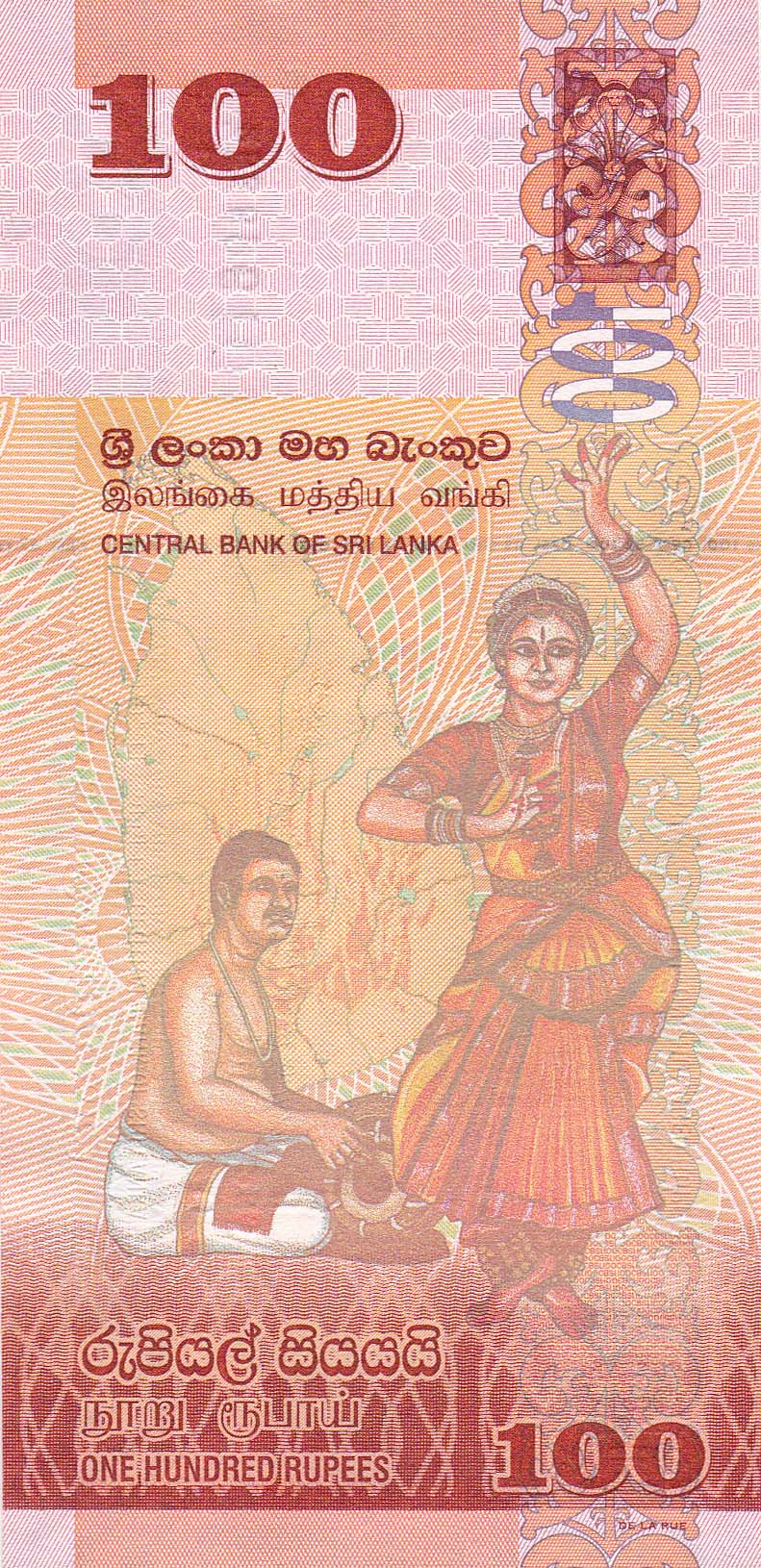
|
Click image to see Note Security under UltraViolet illumination
Front: Landscape
An artist's impression of NOROCHCHOLAI COAL POWER PLANT and an
early view of Laxapana waterfall with surrounding power cables to upper left.
Illustrated are
the Sri Lanka bird Orange Billed Babbler to the right, and
the butterfly, Autumn Leaf to the lower left.
|
Numeric 100 at upper left and lower right.
At bottom center the value
රුපියල් සියයයි in Sinhala,
நூறு ரூபாய் in Thamil
and ONE HUNDRED RUPEES in English, of decreasing font size.
ශ්රී ලංකා මහ බැංකුව in Sinhala at Top center, with smaller
இலங்கை மத்திய வங்கி in Thamil
and English CENTRAL BANK OF SRI LANKA on next line.
Legality Legend in 3 lines
ශ්රී ලංකාණ්ඩුව වෙනුවෙන් නිකුත් කරන ලද මේ
මුදල් නෝට්ටුව ශ්රී ලංකාව ඇතුළත ඕනෑම මුදල් ගණනක්
ගෙවිම සඳහා නිතියෙන් වලංගුය
Sri Lankan Lion with sword facing left at upper right.
Facsimile signatures above මුදල් ඈමති, and
the මහ බැංකුවේ අධිපති,
with date YYYY-MM-DD below.
Size of digits in serial number increase in size.
Horizontal Black Serial number on upper left and vertical Red Serial
number on right.
Security Thread Thin polyester thread embedded in note
with the letters CBSL RS100 and Mirror of same.
Back: Portrait
A drawing of Bharatanatyam dancer and a
Mridangam drummer. A Naga guard stone with a
Seven hooded Cobra is on the upper right, on a vertical Band with a
stylized floral motif, Dvithva Liya Vela.
A map of Sri Lanka appears in the background centered to the left.
Numeric 100 at upper left and lower right.
රුපියල් සියයයි in Sinhala,
நூறு ரூபாய் in Thamil
and ONE HUNDRED RUPEES in English,
in 3 lines of decreasing font size, at lower left.
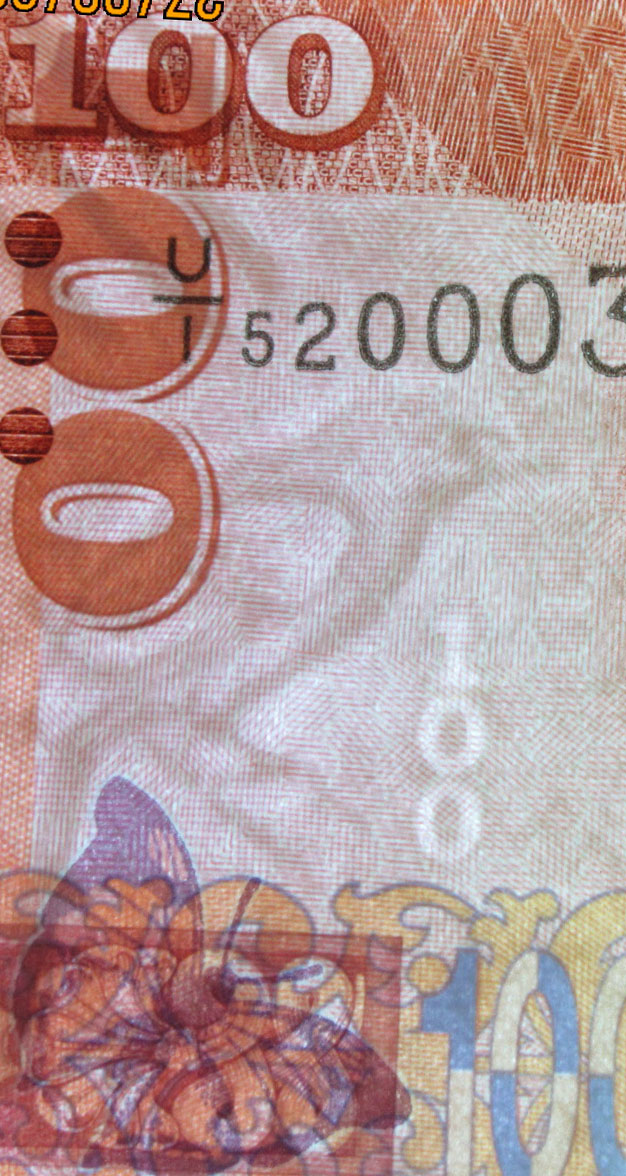 ශ්රී ලංකා මහ බැංකුව
in Sinhala,
இலங்கை மத்திய வங்கி in Thamil
and CENTRAL BANK OF SRI LANKA in English, in 3 lines,
of decreasing font size, at center upper left.
ශ්රී ලංකා මහ බැංකුව
in Sinhala,
இலங்கை மத்திய வங்கி in Thamil
and CENTRAL BANK OF SRI LANKA in English, in 3 lines,
of decreasing font size, at center upper left.
Printer Thomas De la Rue, Sri Lanka, in tiny text DE LA RUE
in bottom right.
Watermark: Cornerstone plus on left same image of Babbler flipped to right, darker than
background with vertical 100 lighter than background to the right.
UV Printing: Random small fiber on both sides.
Front: Minimal. Highlighted Green square with numeric 100 in large Font,
lower right of center. Serial number in Green on left, Orange on right
Back: Limited highlight of Drummer and Dancer.
 Latent image: Right of the top left numeric on front, the
Numeric value 100 written italic with horizontal lines
on a vertical lines background, both slightly tilted clockwise, as
seen on this 1200 dpi scan on right.
Image also show microprinting array of text CBSL.
Latent image: Right of the top left numeric on front, the
Numeric value 100 written italic with horizontal lines
on a vertical lines background, both slightly tilted clockwise, as
seen on this 1200 dpi scan on right.
Image also show microprinting array of text CBSL.
Replacement Notes See details with images for series in
*-Notes
| Predominant Color | : Orange | |
| Size | : 138 x 67 mm
|
| Serial Prefix | : U | |
| Replacement Prefix | : Z/4,Z/30
|
| Florescent Fiber | : Yellow | |
| Braille | : Three Dots
|
CBSL has also issued an uncut sheet of 40 Rs100
notes, with a certificate Authentication hand
signed by the Superintendent of Currency, sold in a tube for
protection. With a face value of Rs4000, it was sold by CBSL for
Rs7000 (US$62.5).
It is the first time that Uncut currency sheets were issued in Sri
Lanka. Printed as a 5 by 8 Array they have a special serial prefix
CB/60 for the Central Bank 60th Anniversary. All notes in a sheet had
last 3 digits of Serial Number the same and 1000 sheets were issued.
Elevan years after issue in 2022 September Wassim Sattar reported that
the Metal caps of the tube that contained the 2010 Rs100 uncut sheet
of 40 is rusting from the inside and out. I checked and confirm.
Not sure what is the best recourse. Maybe put a plastic cap on the
inside to protect the sheet from the rust and some external cover to
reduce the rusting of the metal caps.
Warning
Cut pair
and Triple
notes certified by PMG as uncut, without any indication that they have
been cut from a larger sheet of 40, are being sold on eBay.
Front Landscape both old and New, with endemic Bird and Butterfly
designed by by Artist Mr Kelum Gunasekara.
Back portrait of traditional Sri Lankan drummer and a dancer
designed by Artist Sisira Liyanaarachchi.
Date on
BankNote | Finance Minister | CBSL Governor | First Serial # | Mintage
in K | Replacement
Prefix
|
| 2010-01-01 | Mahinda Rajapaksa | Ajith Nivard Cabraal | U/1 000001 | 210,000 | Z/4
|
| 2010-01-01 | Mahinda Rajapaksa | Ajith Nivard Cabraal | U/211 000001 | 105,000 | Z/4
|
| 2015-02-04 | Ravi Karunanayake | A. Mahendran | U/316 000001 | 50,000 | Z/4
|
| 2015-02-04 | Ravi Karunanayake | A. Mahendran | U/366 000001 | 105,000 | Z/30
|
| 2016-07-04 | Ravi Karunanayake | I. Coomaraswamy | U/471 000001 | 110,000 | SNIM-6.5%
|
| 2017-05-22 | Mangala Samaraweera | I. Coomaraswamy | U/588 200001 | 110,000 | SNIM-8.7%
|
| 2019-01-28 | Mangala Samaraweera | I. Coomaraswamy | U/707 750001 | 15,000 | SNIM-10%
|
| 2019-12-24 | Mahinda Rajapaksa | W. D. Lakshman | U/724 250001 | 35,000 | SNIM-7.3%
|
| 2020-08-12 | Mahinda Rajapaksa | W. D. Lakshman | U/762 050001 | 60.000 | SNIM-7.9%
|
| 2021-09-15 | Basil Rajapaksa | Ajith Nivard Cabraal | U/826 760001 | 80,900 | SNIM-3.5%
|
| 2022-07-04 | Ranil Wickremesinghe | Nandalal Weerasinghe | U/913 000001 | 65,000 | SNIM-6.0%
|
NIY = No information Yet (if printed)
Post UV print coating of varnish is applied on Rs. 100/- currency notes
from U/211 onwards and these notes are slightly thicker
From U/471 SNIM (Single Note Inspection Machine) was used.
Error notes removed, but not replaced with Z serial Replacements.
Packs have missing serial numbers.
Please Help Track Prefix+Serial when Date on Banknote change. Thanks.
The 2017-05-22 dated Rs100 notes appeared in circulation in 2019 October
Mintage of 110M, 110M and 15M notes stated in reply to RTI 0001/2020 is 7.2M (6.5%),
9.55M (8.7%), 1.5M(10%) less than the difference of Last - First Serial for these issues.
The increase of error rate from 0.2-0.3% replacements to about 10%
missing serial numbers with the adoption of SNIM by DeLaRue is
explained by more stringent quality control, but mainly because,
printed sheets are not quality checked before printing Serials.
In May 2021 June I picked up fron Bank of Ceylon aa uncirculated
bundle of 100, 2019-01-28 dated notes. The serial numbers were in 3
sequences ranged over a total of 2000 with only 100 accepted. 95% of
the notes within these ranges had been put in other packs or rejected.
There were only 2 triples and 3 pairs. Rest all singles in 3 sequences.
Note that with the 65M they have printed for the 2022-07-04 issue the
last prefix will be in the U/980s. So unless they issue a new series,
they would need to use 4 digits in prefixes or use a new alphabet
letter for the next order. Will we have the same signatures + date and
different alpha prefix character for the Rs100/-?
Norochcholai coal power plant
The Norochcholai coal power plant is a lead project of the government
to enhance economic growth and ensure balanced regional development
through cost effective power sector development. It is expected that
this first coal power plant in Sri Lanka will cater to the increasing
demand of electricity initially by 300 MW with an ultimate capacity of
900 MW when fully developed.
Laxapana Waterfall
Laxapana waterfall, one of the beautiful creations of Mother Nature is
129m high and is situated in Hatton area in the Nuwara Eliya
district. It is formed by the Maskeliya Oya. The fall gives rise to
twin hydroelectricity power stations, Laxapana and New Laxapana.
Sri Lanka Orange -billed Babbler - Turdoides rufescens
Sri Lanka Ratu Demalichcha (Sinhala)
llangai Sevvalahu Velaikkara Kuruvi (Thamil)
Sri Lanka Orange -billed Babbler is an old world babbler with soft
fluffy plumage, short rounded wings and a weak flight. It is
distinguished from its rufous colouration and orange beak and legs. It
is an endemic, common in the wet zone forests and adjacent
gardens. This bird is categorized as vulnerable by the IUCN.
The Autumn Leaf - Doleschallia bisaltidae
Sarakolaya (Sinhala)
As its name suggests its wings are similar to the bright amber
coloured leaves. It has bright orange colour forewings and its
underside resembles a dead leaf, which gives it greater measure of
camouflage. Its camouflage makes it harder to spot.
Naga guard stone
The cobra was considered as the guardian of water and treasure. It is
suggested that the guard stone carved with the nagaraja symbol at the
entrance to ancient buildings represents protection to the
building. The sculpture of multi-headed cobra incorporates the belief
that when people die they are reincarnated as cobras to protect the
treasures.
Dvithva Liya vela
Traditional Sinhalese art has a floral motifs depicted with two
similar creepers called Dvithva liya vela. These flower bands are
combined or run parallel to each other in a regular pattern.
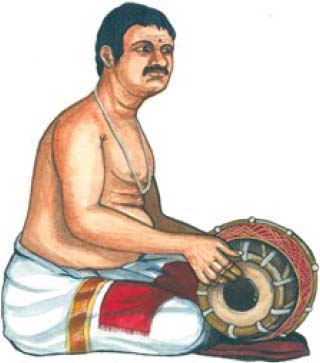
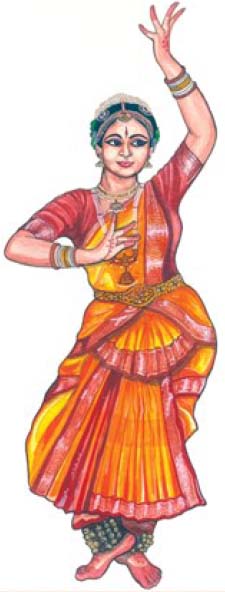 Bharatanatyam
Bharatanatyam
Bharatanatyam is a classical Indian dance form popular in Sri
Lanka. In ancient India, the devadasis had performed
Bharatanatyam in Tamil Nadu. Women wear a typical saree in the
dance performance, men have bare chest and wear a dhoti-like outfit in
the lower part of the body. It is performed with the knees of the
dancers bent and the dance form uses hand movements to convey
different kinds of emotions to the audience. The main drum used is the
Mridangam
Mridangam
The Mridangam is a doubleesided drum used as accompaniment in the
Bharatanatyam dances. It is also the main percussion instrument used
in Carnatic concerts.
Text edited from Press Releases of the CBSL.
For collected details of the images on this Banknote see
NotesCollector.
In 2018 Rs100 currency Notes dated 2016-07-04 with Signatures of
Ravi Karunanayake & I. Coomaraswamy appeared in Circulation. Note
with U/470 dated 2015-02-04 was found the U/470 which exceeded the
CBSL posted max for that date which has put into question the ranges
of Serial numbers used for each date and was corrected with reply to RTI.
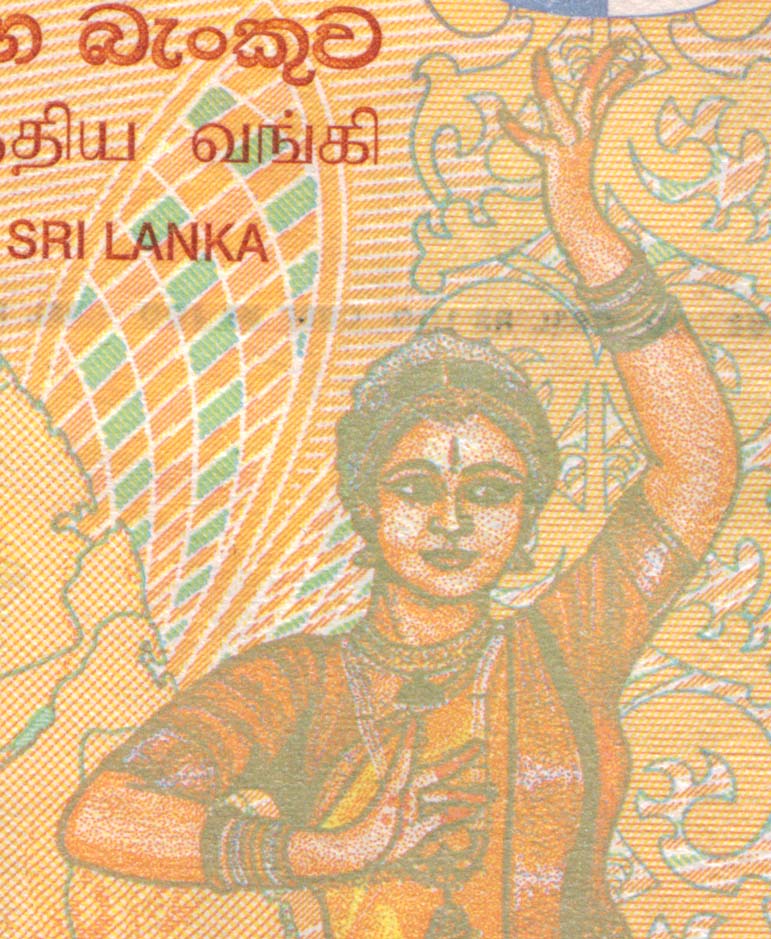 Shehan Patterson has observed that the image of female dancer doing
the Bharatanatyam on the back of the Rs100/- note has been drawn with
only 4 fingers. On the hand stretched above the head the thumb could
be hidden from view. But the hand close to the body could not have any
fingers hidden from view, based on the pose and the different heights
of fingers.
Shehan Patterson has observed that the image of female dancer doing
the Bharatanatyam on the back of the Rs100/- note has been drawn with
only 4 fingers. On the hand stretched above the head the thumb could
be hidden from view. But the hand close to the body could not have any
fingers hidden from view, based on the pose and the different heights
of fingers.
I wonder if this error would get corrected and this first issue become
rare like the 1991 Rs100 note where there was a missing dot in a
Thamil character.





 Latent image: Right of the top left numeric on front, the
Numeric value 100 written italic with horizontal lines
on a vertical lines background, both slightly tilted clockwise, as
seen on this 1200 dpi scan on right.
Image also show microprinting array of text CBSL.
Latent image: Right of the top left numeric on front, the
Numeric value 100 written italic with horizontal lines
on a vertical lines background, both slightly tilted clockwise, as
seen on this 1200 dpi scan on right.
Image also show microprinting array of text CBSL.
 Bharatanatyam
Bharatanatyam  Shehan Patterson has observed that the image of female dancer doing
the Bharatanatyam on the back of the Rs100/- note has been drawn with
only 4 fingers. On the hand stretched above the head the thumb could
be hidden from view. But the hand close to the body could not have any
fingers hidden from view, based on the pose and the different heights
of fingers.
Shehan Patterson has observed that the image of female dancer doing
the Bharatanatyam on the back of the Rs100/- note has been drawn with
only 4 fingers. On the hand stretched above the head the thumb could
be hidden from view. But the hand close to the body could not have any
fingers hidden from view, based on the pose and the different heights
of fingers.